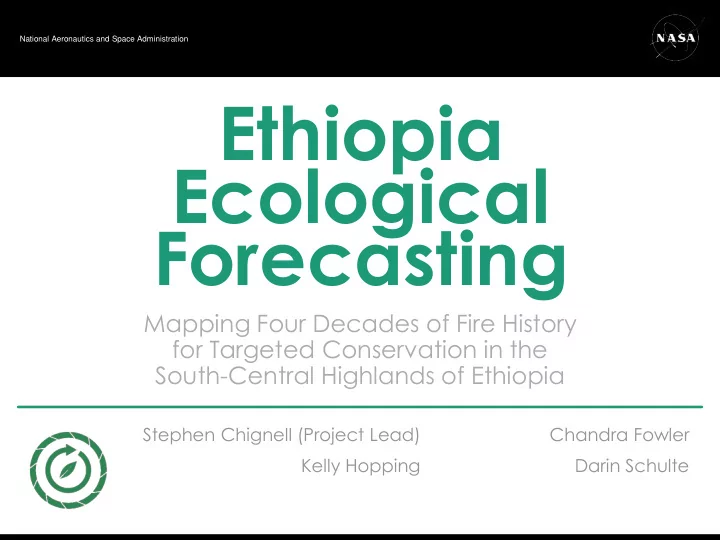

National Aeronautics and Space Administration Ethiopia Ecological Forecasting Mapping Four Decades of Fire History for Targeted Conservation in the South-Central Highlands of Ethiopia Stephen Chignell (Project Lead) Chandra Fowler Kelly Hopping Darin Schulte
Bale-Arsi Massif, Ethiopia WRS2 Path 167 Row 55 Elevation (m) ¯ Bale Mountains National Park 4517 3000 15 60 0 30 90 120km WRS2 Path 167 Row 55 2000 1000 Study area 500
Community Concerns Positive effects of intentional burning on social-ecological system functioning Negative effects of increased fires on wildlife habitat and soil erosion Negative consequences of forced burning cessation Efficacy of past and future conservation efforts Limited capacity and data availability Image Credits: (top) Rod Waddington, (bottom) Stephen Chignell
Objectives Quantify fire extent and distribution on the Bale-Arsi massif over a 42-year time period Provide land managers with the most current and complete record of fires in the region Compare patterns of burning to observed land changes Demonstrate a reproducible methodology Image Credits: Stephen Chignell
National Aeronautics and Space Administration Methodology
Work flow Data Data Data Analysis Results Acquisition Acquisition Processing Landsat Time Series MSS, SRTM Tasseled Cap imagery LandsatLinkr Visualization Compositing TM, ETM + Fire extent Gap-filling & Normalized Thresholding Burn Burn Ratio Frequency OLI Land Cover Landsat MODIS Aggregation Assessment Validation burned area
Earth Observations Shuttle Radar Landsat 1, 3 Terra/Aqua Topography Mission Multispectral Scanner MODIS (SRTM) (MSS) Landsat 5 Landsat 7 Landsat 8 Thematic Mapper Enhanced Thematic Operational Land (TM) Mapper (ETM+) Imager (OLI)
Data Acquisition & Pre-processing Landsat imagery Atmospheric LandsatLinkr correction Cloud mask Georegistration Spectral calibration
Tasseled cap visualization (1973-2015) Brightness + Greenness + Wetness Composite
Burned area mapping (1995-2015)
Gap-filling burned areas
Detecting burned areas with clouds January 30, 2015 January 30, 2015 February 7, 2015 February 7, 2015 March 11, 2015 March 11, 2015 March 19, 2015 March 19, 2015
Post-processing Aggregate burned areas within each year Clip to areas higher than 3000 m Sieve out burned areas < 1 hectare (11 pixels) to eliminate noise Remove erroneous burned areas detected on Tulu Deemtu
National Aeronautics and Space Administration Results
Time series visualization
Landsat & MODIS spatial extents Landsat NBR MODIS MCD45A Cumulative MODIS MODIS MCD64A Potential Landsat burned area covered by clouds (86 km 2 ) Landsat : 274 km 2 MCD45A1 : 260 km 2 MCD64A1 : 222 km 2
Landsat and MODIS time series
Spatial patterns of burning (Photo credits: Johansson et al. 2012 Ecology and Society)
Vegetation types burned Sparse veg. Alpine shrub 3.0% 14.7% Grasslands 3.7% Herbaceous 6.3% Deciduous 0.5% Erica shrub 71.6%
Vegetation types burned Sparse veg. Alpine shrub 3.0% 14.7% Grasslands 3.7% Herbaceous 6.3% Deciduous 0.5% Erica shrub 71.6%
Ericaceous shrub burned Erica shrubland Burned inside park Burned outside park Years with fires Bale Mountains National Park
Wildlife habitat burned 1600 Burned 1400 17% Unburned 1200 Habitat area (km²) 1000 800 600 5% 400 200 0 Mountain nyala Ethiopian wolf Image Credits: Paul Evangelista
National Aeronautics and Space Administration Discussion
Errors and uncertainties Gaps in the Landsat record for the region. Scan line interpolation. Potentially omitted fires due to cloud cover.
Conclusions 35% of ericaceous vegetation burned in the Bale Mountains between 1995-2015, but few areas experienced repeated fires . LandsatLinkr expedites pre-processing , but data gaps and cloud cover remain challenging for time series analysis in remote, tropical alpine regions. Final products for partners: Maps and spatial data of fire extent and frequency (1995-2015) Spectrally comparable and composited tasseled cap time series (1973-2015)
Future work Density analyses Galama Mountains Sentinel 2 data Incorporate field data
Acknowledgements Advisors Dr. Paul Evangelista, Natural Resource Ecology Laboratory, Colorado State University Partners The Murulle Foundation Natural Resource Ecology Laboratory , Colorado State University Others Nicholas Young, The Murulle Foundation and Natural Resource Ecology Laboratory, Colorado State University Justin Braaten, Oregon State University Brian Woodward, NASA DEVELOP Dr. Amanda West, Colorado State University This material is based upon work supported by NASA through contract NNL11AA00B and cooperative agreement NNX14AB60A.
Recommend
More recommend